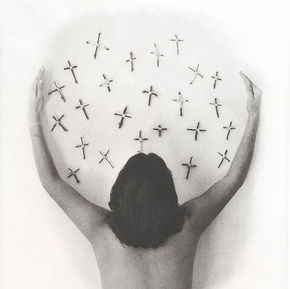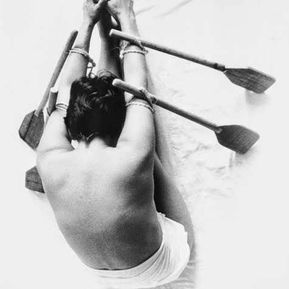FOTOTECA SIRACUSANA
PHOTOGALLERY - FOTOGRAFIA VINTAGE - BIBLIOTECA TEMATICA - CAMERA OSCURA B&W - DIDATTICA
SCRIPTPHOTOGRAPHY

MARTA MARIA PEREZ BRAVO
Il sacro è un prodotto culturale e dunque muta da contesto a contesto. Non c’è civiltà, dunque, che non abbia una propria idea di sacro pronta che, a sua volta, è pronta a cambiare con il divenire storico: il sacro è pertanto una variabile della Storia. L’espressione del sacro non è una condizione morale o spirituale, ma una condizione inerente alle relazioni che l’uomo avverte come superiori a sé: non potendole dominare le consegna a una dimensione definita come “divina”. La nozione di sacro pertanto è mutevole. E spesso, come nel caso della Santería afro-caraibica, ricca di commistioni sincretiche con la religione cattolica. Il lavoro della fotografa cubana Marta María Pérez Bravo ruota intorno al suo background culturale attraverso uno sguardo obliquo, spesso onirico, col quale rappresentare una serie di esperienze che trova nella corporeità – spesso si tratta di autoritratti della stessa fotografa- il terreno in cui stabilire il legame tra il mondo terreno e quello divino. La ritualità pagana, importata dagli schiavi africani e affollata da elementi panteisti, incontra la rigida espressione monoteista in una liturgia simbolista che immette nella concezione del sacro elementi di una ritualità che affonda le sue radici direttamente nella magia. Noi non sappiamo del percorso spirituale della fotografa ma è certo che la sua formazione culturale è intrisa di un respiro sospeso tra magia e fede, tra “stregoneria” e dottrina. Come si è detto, nelle fotografie di Marta María Pérez Bravo è il corpo femminile il “luogo” sincretico tra i due aspetti spirituali e quindi i simboli dei riti compaiono alternandosi in un gioco a metà tra l’astrazione e l’onirico. Fotografie di piccolo formato, sempre in bianco e nero, allusive e dolenti, sospese tra martirio e devozione. Le figure non appaiono quasi mai per intero, spesso è il dettaglio che ha la supremazia descrittiva e dunque, nell’assegnazione del ruolo di spiegare una parte per il tutto, il resto può essere tralasciato. Tuttavia, come in una specie di riassunto grafico, le figure sembrano emergere da uno spazio il cui biancore non riesce a frenarne la potenza o, più spesso contornate da un alone che ha il compito di circondare, e dunque di “sistemare” i soggetti a favore di lettura, come se Marta María Pérez Bravo ci invitasse a focalizzare la nostra attenzione, a non disperderla in un altrove senza risposte. Quanto è rappresentato è distante dalla cultura spirituale Occidentale e pertanto può sfuggirci il senso della presenza degli oggetti in relazione alla persona, tuttavia – salvo gli elementi presenti più prossimi a noi, come croci, corone e stimmate – percepiamo l’impressione di una sacralità che, sebbene oscura, in qualche modo dialoga nel profondo con la nostra sensibilità. Marta María Pérez Bravo ci trascina in un mondo fantastico e ricco di rimandi da decifrare. Noi ne ammiriamo l’ardire mentre accogliamo l’esistenza di una tradizione secolare che sopravviverà ai suoi detrattori. Ciò che esiste, ha scritto Kant, ha una sua ragione. E noi siamo d’accordo, le tracce dell’esistenza le osserviamo foro dopo foto nell’intrigante e misterioso lavoro di Marta María Pérez Bravo.
Giuseppe Cicozzetti
foto Marta María Pérez Bravo
The sacred is a cultural product and it changes from context to context. There is no civilization, therefore, that does not have its own idea of sacred ready that, in turn, is ready to change with the historical becoming: the sacred is therefore a variable of History.
The expression of sacred is not a moral or spiritual condition, but a condition inherent in relationships that man perceives as superior to him: not being able to dominate the delivery to a dimension defined as "divine".
The notion of sacred therefore is changeable. And often, as in the case of Afro-Caribbean Santería, rich in syncretic mixtures with the Catholic religion.
The Cuban photographer Marta María Pérez’s work Bravo revolves around her cultural background through an oblique, often oneiric gaze, with which to represent a series of experiences that she finds in corporeity - often it is self-portraits of the same photograph- the terrain in which to establish the link between the earthly and the divine world.
The pagan ritual, imported from African slaves and crowded with pantheistic elements, meets the rigid monotheistic expression in a symbolist liturgy that introduces into the conception of the sacred elements of a ritual that sinks its roots directly into magic. We don’t know about the spiritual journey of the photographer but it is certain that her cultural formation is imbued with a breath suspended between magic and faith, between "witchcraft" and doctrine.
As we have said, in the photographs of Marta María Pérez Bravo the female body is the syncretic "place" between the two spiritual aspects and therefore the symbols of the rites appear alternating in a game halfway between abstraction and oneiric. Photographs of small format, always in black and white, allusive and painful, suspended between martyrdom and devotion. The figures do not appear almost never in full, often it is the detail that has descriptive supremacy and therefore, in the assignment of the role of explaining a part for the whole, the rest can be left out.
However, as in a sort of graphic summary, the figures seem to emerge from a space whose whiteness can not restrain its power or, more often, surrounded by a halo that has the task of surrounding, and therefore to "arrange" the subjects to favor of reading, as if Marta María Pérez Bravo invited us to focus our attention, not to disperse it in an elsewhere without answers.
What is represented is distant from the Western spiritual culture and therefore the sense of the presence of objects in relation to the person can escape us, however - except for the elements present closest to us, such as crosses, crowns and stigmata - we perceive the impression of a sacredness that, although obscure, somehow dialogues deeply with our sensitivity. Marta María Pérez Bravo drags us into a fantastic world full of references to be deciphered.
We admire her audacity while welcome the existence of a centuries-old tradition that will survive its detractors. What exists, Kant wrote, has its own reason. And we agree, the traces of existence are observed in the photo after hole in the intriguing and mysterious work of Marta María Pérez Bravo.
Giuseppe Cicozzetti
ph. Marta María Pérez Bravo











